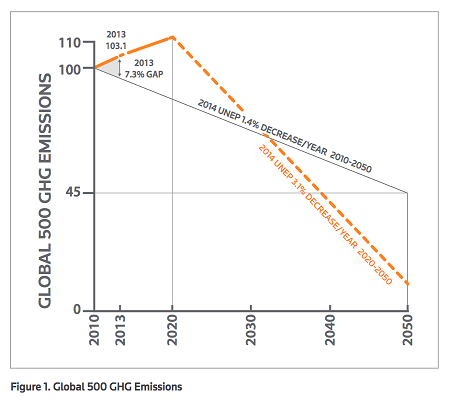There is a sizeable gap which we need to close between the amount of greenhouse-gases we are currently putting in the atmosphere, and the amount that we should be putting in the atmosphere to stay within 2 degrees centigrade of warming. This gap has been calculated and when measured from 2010 to 2050 it indicates that we need to reduce our GHG footprint by roughly 1.4% annually. If the rate of decrease is not implemented in the early years, the model forecasts that it will need to recede much faster in later years.
What does this mean in practice?
For corporations, it signifies the need for transparency about emissions so that they are measureable and manageable. The Global 500 fossil fuel sector alone emits about 30% of total GHG every year, if you include the use of gasoline and other products related to coal, oil and natural gas. Secondly, each company must take responsibility for reducing its footprint by at least 1.4% per year, including in the purchase of energy and in supply chains. It is not responsible to say “that is not our footprint, it’s our supplier’s”. Holistic transparency and responsibility is key at the corporate level, especially as companies continue to grow the size of their businesses.
Individuals must also bear responsibility for their actions over the course of their lifetimes. How much water, energy and GHG are emitted through cars, air travel, consumer products and food? Again, the metric is the same. Reduce the footprint by 1.4% per year or more, and encourage everybody to adopt practices which add up over the course of a lifetime.

Source: Thomson Reuters, GLOBAL 500 GREENHOUSE GAS REPORT: THE FOSSIL FUEL ENERGY SECTOR
Who else is involved?
For nation-states, the core area of importance is policy. Are laws and regulations subsidizing carbon-intensive industry? Is there consideration of a carbon tax which accurately reflects the costs of GHG emissions on the environment and global welfare? Do politicians hold well-informed views on climate change and if so, are they pursuing policy-making which reflects the urgency of the problem? Do nations have an appreciation of the level of risk they are putting on island nations, and low lying coastal areas in the developing world? Finally, are nations requiring their industry and government branches to be transparent about emissions, and are they complying with the 1.4% target in their INDCs agreed at COP21?
From a planetary perspective, all three actors: corporations, individuals, and nation-states, are crucial. We are coming off the hottest year on record. Greenhouse gas concentrations in the atmosphere are approaching levels consistent with much higher sea-levels in comparison to the historical record over the last 50,000 years. We must mind the greenhouse gap across these three key constituencies, or the consequences will be dire.
The views and opinions expressed in this article are those of the authors and do not necessarily reflect the views of The Economist Intelligence Unit Limited (EIU) or any other member of The Economist Group. The Economist Group (including the EIU) cannot accept any responsibility or liability for reliance by any person on this article or any of the information, opinions or conclusions set out in the article.




